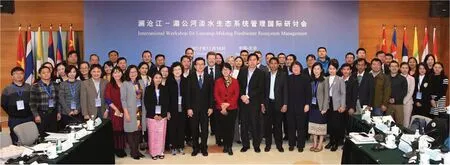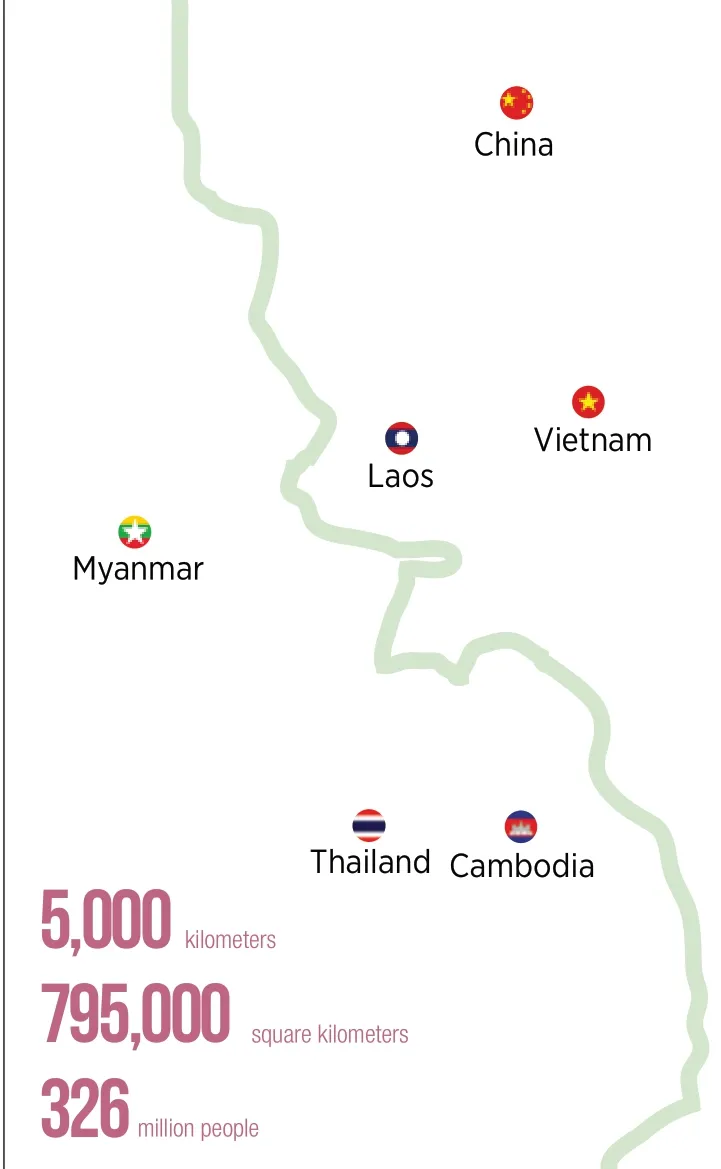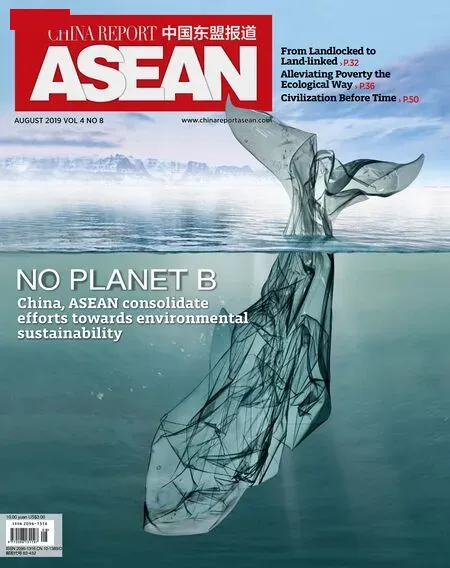Effective meas Aures haRve beeIn tVakenE to pRrotect thFe waOter enRviron meAnt oLf the LLancang-Mekong River
By Yuan Yanan

Group photo of participants at the International Workshop for Lancang-Mekong Freshwater Ecosystem Management held in Beijing, November 16, 2017.
Luang Namtha Provincial Secondary School in Luang Namtha County, Luang Namtha Province in northwestern Laos serves nearly 2,000 students as the only provinciallevel secondary school in the province. Because the school previously lacked sewage treatment equipment, domestic sewage was directly discharged without treatment, which not only posed a health threat to teachers and students, but also polluted nearby rivers that feed the Mekong River.
With support of the Lancang-Mekong Cooperation Fund, the Lancang-Mekong Environmental Cooperation Center (LMEC) joined hands with the Lancang-Mekong Environmental Cooperation Yunnan Center and other relevant organizations to raise funds for an integrated sewage treatment facility capable of processing 50 tons per day and installed it near Luang Namtha Provincial Secondary School in 2018. Thanks to the project, the sewage treatment rate of the school has reached 100 percent, and treated wastewater can be recycled without outflow, secondary pollution or other problems.
Treated sewage can now be recycled for irrigation and other uses, which effectively solves the sewage problem and brings a great relief to teachers and students at the school. After construction was completed, the contractor trained the staff of the school to make sure the equipment is properly operated and maintained.
“The water from the sewage treatment facility is used for many things such as watering the flowers and trees in school and washing clothes,” declared a student from Luang Namtha Provincial Secondary School. “I would like to express my sincere gratitude to China's Ministry of Ecology and Environment for helping our school build the sewage treatment facility.”
The project at Luang Namtha Provincial Secondary School is just one piece of the Green Lancang-Mekong Initiative, a flagship project to implement the Lancang-Mekong Environment Cooperation Strategy, which was adopted by China and other five nations along the Lancang-Mekong River in January 2018.
Crucial Regional Cooperation
The Lancang-Mekong is an international river that runs through China, Laos, Myanmar, Thailand, Cambodia and Vietnam. Lancang-Mekong countries face similar issues and challenges in terms of environmental protection and sustainable development.
Rapid economic development in this region has exerted heavy pressure on ecosystems and the climate. Increasing unsustainable consumption patterns have led to worsening pollution and degraded quality of air, water and soil. An estimated 326 million people in six countries depend on the river, so cooperation on water protection has become crucial.
The Lancang-Mekong Cooperation (LMC) mechanism was officially launched in March 2016 in the Chinese city of Sanya. It is the first subregional cooperation body involving the six countries and aims to promote economic and social development, improve living standards and shrink the development gap among these countries. Under the LMC framework, China founded the LMEC to provide a dialogue platform and promote cooperation in ecological environmental protection.
“We are pleased about the LMC framework,” declared Sok Siphana, chairman of the National Secretariat of Cambodia for LMC. “It enables us to closely cooperate to ensure mutual benefits and sustainable development in the region based on the principle of integrated water resources management.”
“Cambodia is committed to cooperation within the platform,” reported Te Navuth, secretary general of the Cambodia National Mekong Committee. “For Cambodia, the main concerns related to Lancang-Mekong protection are climate change, natural disasters, irrigation, hydroelectric development in the basin, rising social demands and people's expectations on living standards and water, food and energy security.” He believed the LMC mechanism will play a bigger role in addressing those challenges.
Practical Steps
Various measures have been taken to protect the water environment of the Lancang-Mekong River.

Lancang is the Chinese name for the upper reaches of the Mekong River. The waterway stretches nearly 5,000 kilometers through the six countries. Its drainage area of about 795,000 square kilometers is home to 326 million people.
Capacity building through sharing advanced technology is one effective method. Since its founding, the LMEC has provided a solid platform for capacity building. From March 23 to April 1, representatives from the environmental authorities and relevant departments of Cambodia, Laos, Myanmar, Thailand and Vietnam met in Nanning, Guangxi, China for an activity composed of 14 courses and 16 field visits. “We learned a lot during this activity,” admitted Nuntaporn Kaewchimpre from the Thai Ministry of Industry. “Not only did we gain theoretical knowledge, but also practical experience and valuable data on environmental laws and water system management of Lancang-Mekong countries as well as application scenarios suitable for wastewater treatment and water environmental monitoring in Thailand.” Bossco Technology, a company that produces cutting-edge environmental technology, co-sponsored the activity. The company also provides scholarship for young scholars from other Lancang-Mekong countries to study in China.
Alongside other organizations, LMEC also conducted research programs to provide data for further Lancang-Mekong cooperation. Their research mainly focused on water environment standards, water quality improvement, management of water pollution, clean water programs and hydroelectric development. The Lancang-Mekong Freshwater Ecosystem Management Program, for example, aims to refine the Freshwater Health Index (FHI), boost regional management abilities and provide executive support. Xishuangbanna Dai Autonomous Prefecture of Yunnan Province was tentatively chosen as the pilot region. An FHI evaluation system was used to assess the county's ecological health level. It provided support and references for future ecological work throughout the basin.
The LMEC also facilitates bilateral communication. On June 28, 2017, the China-Cambodia Aquatic Environment Management and Practice Seminar was held in Phnom Penh, Cambodia. More than 50 relevant officials from the Ministry of Environment of Cambodia joined local environmental authorities around Tonlé Sap Lake in attending the seminar.
At the multilateral level, roundtable dialogues have been held. The latest took place on March 20-21, 2019. The Lancang-Mekong Roundtable Dialogue on the Outlook for Strategic Environmental Assessment was held in Kunming, capital of southwestern China's Yunnan Province, as part of a series of Lancang-Mekong Environmental Cooperation Roundtable Dialogues. Representatives from agencies directly under the Chinese government, environmental departments of Mekong countries, industrial sectors, research institutions, international organizations and businesses attended the meeting. The participants indicated that constant communication and exchange would help improve regional freshwater ecosystem management and sustainable utilization of regional ecosystem.
Nurtured by the same river, China and other Lancang-Mekong countries know well about a community with a shared future. Through working hand in hand, the six countries will jointly improve the water environment of the Lancang-Mekong River and promote regional sustainable development.
- China Report Asean的其它文章
- CHINESE, VIETNAMESE COMMUNIST PARTIES HOLD 15TH THEORY SEMINAR
- SEIZING SUSTAINABLE SOLUTIONS CHINA SETS THE STANDARD FOR ALLEVIATING POVERTY AND PROMOTING ONGOING GROWTH
- CHINESE VP MEETS MALAYSIAN DEPUTY PM
- 2019 CHINAASEAN EDUCATION COOPERATION WEEK
- NO PLANET B
- LI: MORE OPEN, TRANSPARENT, PREDICTABLE CHINA FOR FOREIGN INVESTMENT

